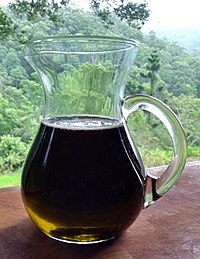
Photo from wikipedia
Abstract The last climate change forecasting and the water scarcity scenarios in many semi-arid agricultural areas worldwide, such as the southern Spain, are promoting changes in the crop pattern of… Click to show full abstract
Abstract The last climate change forecasting and the water scarcity scenarios in many semi-arid agricultural areas worldwide, such as the southern Spain, are promoting changes in the crop pattern of irrigated agriculture, being introduced new species characterized by its water-stress tolerance. In the last few years, there is an increasing interest in the cultivation of industrial hemp (Cannabis sativa L.) to manufacture therapeutic products derived from non-psychotropic cannabinoids and other secondary metabolites. This work evaluates the agronomical response of two industrial hemp cultivars (Carma and Ermes) subjected to different management practices. The trial was conducted during two seasons (2012–2013), from April to October. During this monitoring period, different plant densities (PD), sowing times (ST), irrigation doses (ID) and cropping systems (CS) were evaluated. At the end of each season, yield parameters (fresh and dry weight, dry weight of flowers and leaves, and the ratio between this late and total dry weight) were obtained. Moreover, the content of the most relevant cannabinoids (CBG, CBD, Δ9-THC, and CBC) were measured in both cultivars, and for the different growth conditions considered. According to our findings, both cultivars evidenced similar responses with significant improvements for the earliest ST (at the end of April) and the highest PD (33,333 and 16,667 plants ha−1). In relation to the ID, not clear responses were observed in terms of active biomass production, being the effects depending on the interactions between PD and ST. Finally, it was noticeable the improvements related to the active biomass production and cannabinoids content when plants were grown under plastic macro-tunnels (among 1.3 and 2 times higher, depending on the cultivar) in comparison to the obtained results under open field conditions.
Journal Title: Industrial Crops and Products
Year Published: 2019
Link to full text (if available)
Share on Social Media: Sign Up to like & get
recommendations!